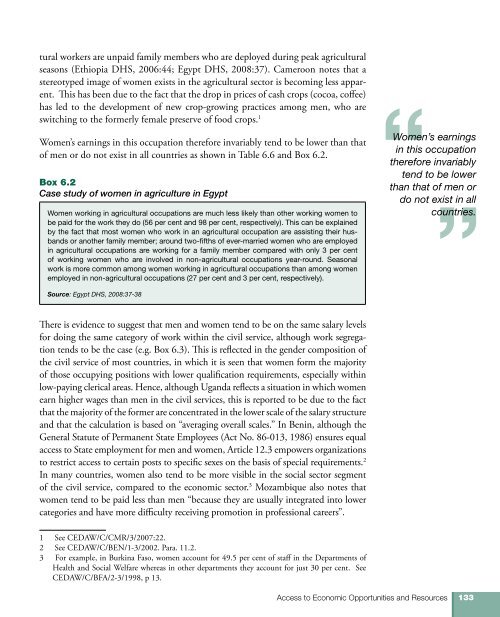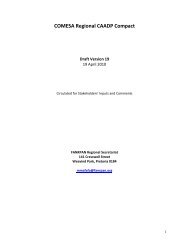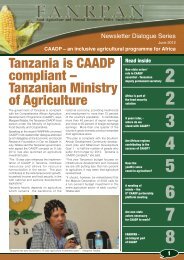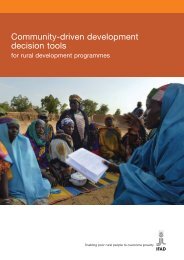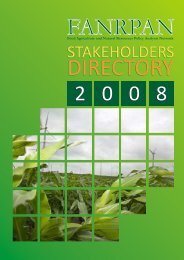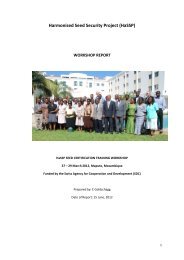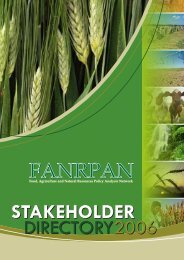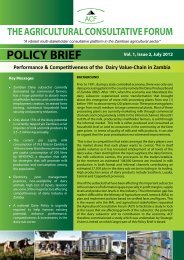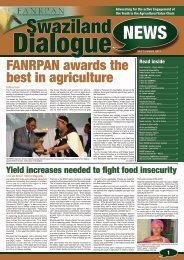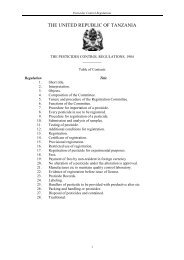African Women's Report 2009 - United Nations Economic ...
African Women's Report 2009 - United Nations Economic ...
African Women's Report 2009 - United Nations Economic ...
You also want an ePaper? Increase the reach of your titles
YUMPU automatically turns print PDFs into web optimized ePapers that Google loves.
tural workers are unpaid family members who are deployed during peak agriculturalseasons (Ethiopia DHS, 2006:44; Egypt DHS, 2008:37). Cameroon notes that astereotyped image of women exists in the agricultural sector is becoming less apparent.This has been due to the fact that the drop in prices of cash crops (cocoa, coffee)has led to the development of new crop-growing practices among men, who areswitching to the formerly female preserve of food crops. 1Women’s earnings in this occupation therefore invariably tend to be lower than thatof men or do not exist in all countries as shown in Table 6.6 and Box 6.2.Box 6.2Case study of women in agriculture in EgyptWomen working in agricultural occupations are much less likely than other working women tobe paid for the work they do (56 per cent and 98 per cent, respectively). This can be explainedby the fact that most women who work in an agricultural occupation are assisting their husbandsor another family member; around two-fifths of ever-married women who are employedin agricultural occupations are working for a family member compared with only 3 per centof working women who are involved in non-agricultural occupations year-round. Seasonalwork is more common among women working in agricultural occupations than among womenemployed in non-agricultural occupations (27 per cent and 3 per cent, respectively).Women’s earningsin this occupationtherefore invariablytend to be lowerthan that of men ordo not exist in allcountries.Source: Egypt DHS, 2008:37-38There is evidence to suggest that men and women tend to be on the same salary levelsfor doing the same category of work within the civil service, although work segregationtends to be the case (e.g. Box 6.3). This is reflected in the gender composition ofthe civil service of most countries, in which it is seen that women form the majorityof those occupying positions with lower qualification requirements, especially withinlow-paying clerical areas. Hence, although Uganda reflects a situation in which womenearn higher wages than men in the civil services, this is reported to be due to the factthat the majority of the former are concentrated in the lower scale of the salary structureand that the calculation is based on “averaging overall scales.” In Benin, although theGeneral Statute of Permanent State Employees (Act No. 86-013, 1986) ensures equalaccess to State employment for men and women, Article 12.3 empowers organizationsto restrict access to certain posts to specific sexes on the basis of special requirements. 2In many countries, women also tend to be more visible in the social sector segmentof the civil service, compared to the economic sector. 3 Mozambique also notes thatwomen tend to be paid less than men “because they are usually integrated into lowercategories and have more difficulty receiving promotion in professional careers”.1 See CEDAW/C/CMR/3/2007:22.2 See CEDAW/C/BEN/1-3/2002. Para. 11.2.3 For example, in Burkina Faso, women account for 49.5 per cent of staff in the Departments ofHealth and Social Welfare whereas in other departments they account for just 30 per cent. SeeCEDAW/C/BFA/2-3/1998, p 13.Access to <strong>Economic</strong> Opportunities and Resources 133


